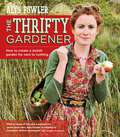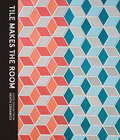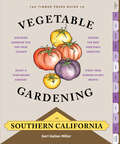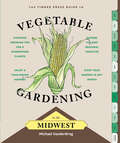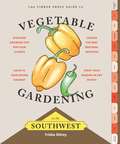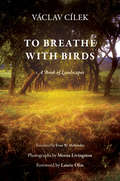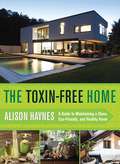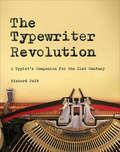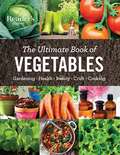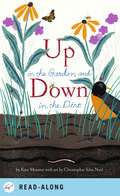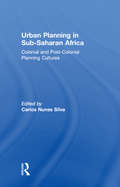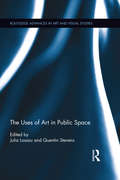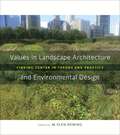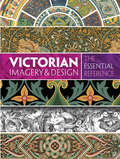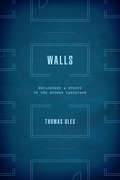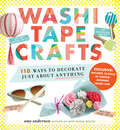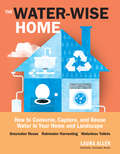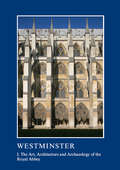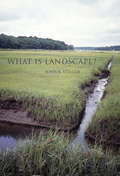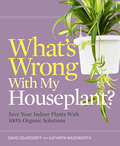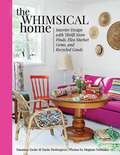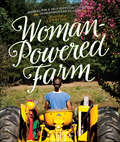- Table View
- List View
The Thrifty Gardener: How To Create A Stylish Garden For Next To Nothing
by Alys FowlerForget makeover culture and all your gardening preconceptions, this is a witty, wise and practical take on to how to create a garden that suits you. The Thrifty Gardener is about creating the garden of your dreams, regardless of resources or limited space. It will eliminate the intimidation factor and reveal the ins-and-outs of soil, seeds, sowing and growing. At the heart of this book is a DIY ethic that says you don't always have to buy what you need, you can make it, take it or swap it with friends. From making window boxes out of wine cases to creating your own stylish compost bin, from bulking up perennials to finding plants for free, this book is packed with offbeat projects for a new generation of gardeners.
Tile Makes the Room
by Robin Petravic Catherine BaileyFrom Heath Ceramics, the beloved California designer, maker, and seller of home goods, comes a captivating and unprecedented look at tile. At its core, Tile Makes the Room is about exceptional spaces and places--the kind you want to step into and examine each and every detail of--where tile is the main ingredient, though not the only star. From the dwellings of notable designers to everyday homeowners, grand installations and subtle designs all showcase tile's role in the form and function of architecture and interiors. With inspiration on every page, a look at tile making from a sixty-year-old design-led manufacturer, a unique perspective on color, pattern, and texture, plus public installations around the world to visit and enjoy, Tile Makes the Room is essential reading on tile and interiors.From the Hardcover edition.
The Timber Press Guide to Vegetable Gardening in Southern California (Regional Vegetable Gardening Series)
by Geri Galian MillerGrow your own food in the Golden State! There is nothing more regionally specific than vegetable gardening—what to plant, when to plant it, and when to harvest are decisions based on climate, weather, and first frost. The Timber Press Guide to Vegetable Gardening in Southern California, by regional expert Geri Miller, focuses on the unique eccentricities of California’s gardening calendar, which include extreme temperatures and low rainfall. The month-by-month format makes it perfect for beginners and accessible to everyone—gardeners can start gardening the month they pick it up.
The Timber Press Guide to Vegetable Gardening in the Midwest (Regional Vegetable Gardening Series)
by Michael VanderBrugHow to grow your own food in the Heartland! There is nothing more regionally specific than vegetable gardening—what to plant, when to plant it, and when to harvest are decisions based on climate, weather, and first frost. The Timber Press Guide to Vegetable Gardening in the Midwest, by regional expert Michael VanderBrug, focuses on the unique eccentricities of the Midwest gardening calendar. The month-by-month format makes it perfect for beginners and accessible to everyone—gardeners can start gardening the month they pick it up. Perfect for home gardeners in Illinois, Indiana, Iowa, Kansas, Michigan, Minnesota, Missouri, Nebraska, North Dakota, Ohio, South Dakota, and Wisconsin.
Timber Press Guide to Vegetable Gardening in the Southwest (Regional Vegetable Gardening Series)
by Trisha ShireyThere is nothing more regionally specific than vegetable gardening—what to plant, when to plant it, and when to harvest are decisions based on climate, weather, and first frost. The Timber Press Guide to Vegetable Gardening in the Southwest, by regional expert Trisha Shirey, focuses on the unique eccentricities of the Southwest gardening calendar, which include extreme temperatures and low rainfall. The month-by-month format makes it perfect for beginners and accessible to everyone— gardeners can start gardening the month they pick it up. Perfect for home gardeners in Arizona, Nevada, New Mexico, Oklahoma, Texas, Utah, eastern California, and southern Colorado.
To Breathe with Birds: A Book of Landscapes (Penn Studies in Landscape Architecture)
by Václav CílekJust as there is love at first sight between people, Václav Cílek writes, there can be love at first sight between a person and a place. A landscape is more than a location, it is one party in a relationship—even when the spirit of a certain setting is not perceptible to those who visit. But whether we travel to experience rapture or excitement, to discover truth and beauty, or to be dazzled, we search for the essence of faraway landscapes to gain perspective on our own place within the world. To Breathe with Birds delves into the imaginative and emotional bonds we form with landscapes and how human existence—a recent development, geologically speaking—shapes and is shaped by a sense of place.In subtle and lyrical prose, renowned geologist and author Václav Cílek explores topics from the history of asphalt to the spirits we imagine in trees, from geodiversity to the mathematics of snowflakes. Weaving earth science and environmentalism together with memoir and myth, his chapters visit resonant locations from India to Massachusetts, though most are deeply rooted in the river-laced, war-scarred landscape of Cílek's Czech homeland. These reflections are accompanied by Morna Livingston's evocative photographs, which capture the beauty and strangeness of natural and human-made forms. The first book-length appearance of Cílek's work in English translation, To Breathe with Birds offers insightful perspectives on the symbolism of landscapes as we struggle to conserve and protect the depleted earth.
The Toxin-Free Home: A Guide to Maintaining a Clean, Eco-Friendly, and Healthy Home
by Alison HaynesWith the amount of junk a family can amass, it seems impossible to keep a tidy home. Home Detox Handbook teaches you how to tackle every cleaning project in your home with ease, from washing stained laundry to scouring kitchen cupboards to creating your own shampoo from household ingredients. The methods presented are not just simple, they are also natural, eco-friendly replacements for store-bought, chemical-filled cleaners. And who wants to subject himself to all the chemical cleaners it takes to keep germs at bay? Alison Haynes has created a comprehensive guide to keeping your home not only sparkling, but also healthy, organized, and running efficiently. Organized by room, each chapter has easy-to-follow instructions for any household query. Here are just some of the amazing tricks Home Detox Handbook will teach you: Use lavender oil as a natural mosquito repellent. Clean and shine patent leather with petroleum jelly. Remove red wine stains from carpets with white wine and rubbing alcohol. Make an organic facial mask for oily skin using ingredients from your fridge. Recycle soap scraps into a whole new cleaner. And many more squeaky-clean tips! With 200 color photographs and step-by-step instructions, Home Detox Handbook is your one-stop resource for eco- and child-friendly solutions to your cleaning needs. From cleaning hardwood floors to getting gum out of hair to reviving limp flowers, this book will help you keep all corners of your home in its best shape. It’s a must-have for anyone managing a household or living on their own for the first time.
The Typewriter Revolution: A Typist's Companion for the 21st Century
by Richard PoltThe connoisseur's guide to the typewriter, entertaining and practical What do thousands of kids, makers, poets, artists, steampunks, hipsters, activists, and musicians have in common? They love typewriters—the magical, mechanical contraptions that are enjoying a surprising second life in the 21st century, striking a blow for self-reliance, privacy, and coherence against dependency, surveillance, and disintegration. The Typewriter Revolution documents the movement and provides practical advice on how to choose a typewriter, how to care for it, and what to do with it—from National Novel Writing Month to letter-writing socials, from type-ins to typewritten blogs, from custom-painted typewriters to typewriter tattoos. It celebrates the unique quality of everything typewriter, fully-illustrated with vintage photographs, postcards, manuals, and more.
The Ultimate Book of Vegetables: Gardening, health, Beauty, Crafts, Cooking
by Editors at Reader's DigestThe Editors of Reader’s Digest present the definitive A-Z guide to vegetables and how to grow and use them.<P> This complete illustrated guide to vegetables unlocks the secrets of nature’s bounty with comprehensive information on the planting, harvesting, and storing of vegetables, together with a wealth of great ideas for using them in cooking, healthcare, crafts, vegetable dyes, home products, beauty treatments, and more.
Up in the Garden and Down in the Dirt (Into Reading Texas, Read Aloud Module 8 #2)
by Christopher Neal Kate MessnerNIMAC-sourced textbook
Up in the Garden and Down in the Dirt
by Kate MessnerIn this exuberant and lyrical follow-up to the award-winning Over and Under the Snow, discover the wonders that lie hidden between stalks, under the shade of leaves . . . and down in the dirt. Explore the hidden world and many lives of a garden through the course of a year! Up in the garden, the world is full of green—leaves and sprouts, growing vegetables, ripening fruit. But down in the dirt exists a busy world—earthworms dig, snakes hunt, skunks burrow—populated by all the animals that make a garden their home. Plus, this is the fixed format version, which will look almost identical to the print version. Additionally for devices that support audio, this ebook includes a read-along setting.
Urban Planning in Sub-Saharan Africa: Colonial and Post-Colonial Planning Cultures
by Carlos Nunes SilvaCities in Sub-Saharan Africa are unequally confronted with social, economic and environmental challenges, particularly those related with population growth, urban sprawl, and informality. This complex and uneven African urban condition requires an open discussion of past and current urban planning practices and future reforms. Urban Planning in Sub-Saharan Africa gives a broad perspective of the history of urban planning in Sub-Saharan Africa and a critical view of issues, problems, challenges and opportunities confronting urban policy makers. The book examines the rich variety of planning cultures in Africa, offers a unique view on the introduction and development of urban planning in Sub-Saharan Africa, and makes a significant contribution against the tendency to over-generalize Africa’s urban problems and Africa’s urban planning practices. Urban Planning in Sub-Saharan Africa is written for postgraduate students and advanced undergraduates, researchers, planners and other policy makers in the multidisciplinary field of Urban Planning, in particular for those working in Spatial Planning, Architecture, Geography, and History.
The Urban Section: An analytical tool for cities and streets
by Robert ManthoThe design of streets, and the connections between streets of different character, is the most important task for architects and urbanists working in an urban context. Considered at two distinct spatial scales – that of the individual street – the Street Section – and the complex of city streets – the City Transect – Urban Section identifies a range of generic street types and their success or otherwise in responding to climatic, cultural, traditional, morphological, social and economic well being. Using comparative studies a profile of best practice in street and city design is identified, showing methodologies in both the analysis of, and design for, successful streets and public places – place-making. In uniquely dealing with both the historic and contemporary description and analysis of urban ‘streets’ around the world, the work is of both academic and professional interest to architects, urban planners and designers, highway engineers, landscape and urban design advisers in both the public and private sectors; students, amenity and civic societies, city authorities and government agencies.
The Uses of Art in Public Space (Routledge Advances in Art and Visual Studies)
by Julia Lossau Quentin StevensThis book links two fields of interest which are too seldom considered together: the production and critique of art in public space and social behaviour in the public realm. Whilst most writing about public art has focused on the aesthetic, cultural and political intentions and processes that shape its production, this edited collection examines a variety of public artworks from the perspective of their actual everyday use. Contributors are interested in the rich diversity of peoples’ engagements with public artworks across various spatial and temporal scales, encounters which do not limit themselves to the representational aspects of the art, and which are not necessarily as the artist, curator or sponsor intended. Case studies consider a broad range of public art, including commissioned and unofficial artworks, memorials, street art, street furniture, performance art, sound art and media installations.
Values in Landscape Architecture and Environmental Design: Finding Center in Theory and Practice (Reading the American Landscape)
by M. Elen DemingThe successful realization of diversity, resilience, usefulness, profitability, or beauty in landscape design requires a firm understanding of the stakeholders' values. This collection, which incorporates a wide variety of geographic locations and cultural perspectives, reinforces the necessity for clear and articulate comprehension of the many factors that guide the design process. As the contributors to this collection reveal, dominant and emerging social, political, philosophical, and economic concerns perpetually assert themselves in designed landscapes, from manifestations of class consciousness in Napa Valley vineyards to recurring themes and conflicts in American commemorative culture as seen in designs for national memorials. One essay demonstrates the lasting impact of the doctrine of Manifest Destiny on the culture and spaces of the Midwest, while another considers the shifting historical narratives that led to the de-domestication and subsequent re-wilding of the Oostvaardersplassen in the Netherlands. These eleven essays help foster the ability to conduct a balanced analysis of various value systems and produce a lucid visualization of the necessary tradeoffs. Offering an array of case studies and theoretical arguments, Values in Landscape Architecture and Environmental Design encourages professionals and educators to bring self-awareness, precision, and accountability to their consideration of landscape designs.
Victorian Imagery and Design: The Essential Reference
by Carol Belanger GraftonRichly detailed, authentic, and engrossing, this compendium draws upon Dover's archives to present a pictorial survey of the Victorian world. Sources include historical periodicals such as Harper's Weekly,The Illustrated London News, and Punch as well as printers' and trade catalogs, architectural graphics, and patterns for fabric and wall decoration by William Morris, Christopher Dresser, and other designers. Hundreds of color and black-and-white images offer glimpses of social history from the great book illustrators of the era as well as ordinary and extraordinary everyday objects, including displays of glassware, furniture, needlework, and stained glass windows from the famous Crystal Palace Exhibition of 1851.Detailed bibliographical information concerning every source - including biographical details of each artist - makes this collection a vital reference tool as well as a stunning compendium of Victorian graphic and pictorial art and illustration. Students of graphic art, typography, and illustration as well as graphic designers and advertising professionals will prize this remarkable resource.
Visualizing the Afterlife in the Tombs of Graeco-Roman Egypt
by Marjorie Susan VenitLost in Egypt's honeycombed hills, distanced by its western desert, or rendered inaccessible by subsequent urban occupation, the monumental decorated tombs of the Graeco-Roman period have received little scholarly attention. This volume serves to redress this deficiency. It explores the narrative pictorial programs of a group of decorated tombs from Ptolemaic and Roman-period Egypt (ca. 300 BCE 250 CE). Its aim is to recognize the tombs' commonalities and differences across ethnic divides and to determine the rationale that lies behind these connections and dissonances. This book sets the tomb programs within their social, political, and religious context and analyzes the manner in which the multicultural population of Graeco-Roman Egypt chose to negotiate death and the afterlife. "
Walls: Enclosure and Ethics in the Modern Landscape
by Thomas OlesStone walls, concrete walls, chain-link walls, border walls: we live in a world of walls. Walls mark sacred space and embody earthly power. They maintain peace and cause war. They enforce separation and create unity. They express identity and build community. Yard to nation, city to self, walls define and dissect our lives. And, for Thomas Oles, it is time to broaden our ideas of what they can--and must--do. In Walls, Oles shows how our minds and our politics are shaped by-and shape-our divisions in the landscape. He traces the rich array of practices and meanings connected to the making and marking of boundaries across history and prehistory, and he describes how these practices have declined in recent centuries. The consequence, he argues, is all around us in the contemporary landscape, riven by walls shoddy in material and mean in spirit. Yet even today, Oles demonstrates, every wall remains potentially an opening, a stage, that critical place in the landscape where people present themselves and define their obligations to one another. In an evocative epilogue, Oles brings to life a society of productive, intentional, and ethical enclosure--one that will leave readers more hopeful about the divided landscapes of the future.
Washi Tape Crafts: 110 Ways to Decorate Just About Anything
by Amy AndersonIt’s the definitive washi tape craft book for adults. Washi tape—the Japanese decorative paper tape that’s easy to tear, peel, stick and re-stick—is transformative, fun, and remarkably easy to use. It’s also never been hotter. Packed full of amazing projects and ideas, it’s the book and tape kit that shows all the ways to be creative with washi tape. The book includes techniques: precision tearing, wrapping, and weaving. How to make bows, rosettes, and other shapes. How to seal and weatherproof designs to make them permanent. And 110 projects, with color photographs and step-by-step instructions, from custom photo frames to one-of-a-kind gifts. The possibilities are endless.
The Water-Wise Home: How to Conserve, Capture, and Reuse Water in Your Home and Landscape
by Laura AllenSave the earth’s most precious resource while also saving yourself money. Laura Allen provides expert strategies for using water smartly and efficiently while fulfilling all of your home and garden needs. Learn how to create a water-wise landscape, reuse greywater, harvest rainwater, and even set up a waterless composting toilet. Offering proven techniques in clear and accessible language, The Water-Wise Home makes it easy to help the environment and lower your household operating costs through conserving water.
Westminster Part I: The Art, Architecture and Archaeology of the Royal Abbey (The British Archaeological Association Conference Transactions)
by Warwick Rodwell; Tim Tatton-BrownThe British Archaeological Association’s 2013 conference was devoted to the study of Westminster Abbey and the Palace of Westminster. It also embraced Westminster School, which was founded at the Reformation in the Abbey precinct. Collectively, these institutions occupy a remarkable assemblage of medieval and later buildings, most of which are well documented. Although the Association had held a conference at Westminster in 1902, this was the first time that the internationally important complex of historic buildings was examined holistically, and the papers published here cover a wide range of subject matter. Westminster came into existence in the later Anglo-Saxon period, and by the mid-11th century, when Edward the Confessor’s great new abbey was built, it was a major royal centre two miles south-west of the City of London. Within a century or so, it had become the principal seat of government in England, and this series of twenty-eight papers covers new research on the topography, buildings, art-history, architecture and archaeology of Westminster’s two great establishments — Abbey and Palace. Part I begins with studies of the topography of the area, an account of its Roman-period finds and an historiographical overview of the archaeology of the Abbey. Edward the Confessor’s enigmatic church plan is discussed and the evidence for later Romanesque structures is assembled for the first time. Five papers examine aspects of Henry III’s vast new Abbey church and its decoration. A further four cover aspects of the later medieval period, coronation, and Sir George Gilbert Scott’s impact as the Abbey’s greatest Surveyor of the Fabric. A pair of papers examines the development of the northern precinct of the Abbey, around St Margaret’s Church, and the remarkable buildings of Westminster School, created within the remains of the monastery in the 17th and 18th centuries. Part II part deals with the Palace of Westminster and its wider topography between the late 11th century and the devastating fire of 1834 that largely destroyed the medieval palace. William Rufus’s enormous hall and its famous roofs are completely reassessed, and comparisons discussed between this structure and the great hall at Caen. Other essays reconsider Henry III’s palace, St Stephen’s chapel, the king’s great chamber (the ‘Painted Chamber’) and the enigmatic Jewel Tower. The final papers examine the meeting places of Parliament and the living accommodation of the MPs who attended it, the topography of the Palace between the Reformation and the fire of 1834, and the building of the New Palace which is better known today as the Houses of Parliament.
What Is Landscape?
by John R. StilgoeA lexicon and guide for discovering the essence of landscape.“Mr. Stilgoe does not ask that we take his book outdoors with us; he believes that reading and experiencing landscapes are activities that should be kept separate. But, as I learned in his book, the hollow storage area in a car driver's door was once a holster, the 'secure nesting place of a pistol.' I recommend you stow your copy there.”—The Wall Street JournalLandscape, John Stilgoe tells us, is a noun. From the old Frisian language (once spoken in coastal parts of the Netherlands and Germany), it meant shoveled land: landschop. Sixteenth-century Englishmen misheard or mispronounced this as landskep, which became landskip, then landscape, designating the surface of the earth shaped for human habitation. In What Is Landscape? Stilgoe maps the discovery of landscape by putting words to things, zeroing in on landscape's essence but also leading sideways expeditions through such sources as children's picture books, folklore, deeds, antique terminology, out-of-print dictionaries, and conversations with locals. (“What is that?” “Well, it's not really a slough, not really, it's a bayou...”) He offers a highly original, cogent, compact, gracefully written narrative lexicon of landscape as word, concept, and path to discoveries.What Is Landscape? is an invitation to walk, to notice, to ask: to see a sandcastle with a pinwheel at the beach and think of Dutch windmills—icons of triumph, markers of territory won from the sea; to walk in the woods and be amused by the Elizabethans' misuse of the Latin silvaticus (people of the woods) to coin the word savages; to see in a suburban front lawn a representation of the meadow of a medieval freehold.Discovering landscape is good exercise for body and for mind. This book is an essential guide and companion to that exercise—to understanding, literally and figuratively, what landscape is.
What's Wrong With My Houseplant?: Save Your Indoor Plants With 100% Organic Solutions (What’s Wrong Series)
by David Deardorff Kathryn WadsworthThis book will turn even the brownest thumbs green! Houseplants add style, clean the air, and bring nature indoors. But they are often plagued with problems—aphids, mealybugs, mites, and thrips to name just a few. What’s Wrong With My Houseplant? shows you how to keep indoor plants healthy by first teaching you how to identify the problem and solve it with a safe, natural solution. This hardworking guide includes plant profiles for 148 plants organized by type with visual keys to the most of common problems, and the related organic solutions that will lead to a healthy plant.
The Whimsical Home: Interior Design with Thrift Store Finds, Flea Market Gems, and Recycled Goods
by Susanna Zacke Sania HedengrenVintage clothing, vintage décor--it simply never gets old and continues to be one of the hottest style trends! Now, you too can create a beautiful vintage home environment that is sure to be the envy all your peers. In The Whimsical Home, master crafters Sania and Susanna show us five different homes furnished with different vintage pieces. Each chapter ends with tips to achieve these fun and whimsical looks. And the best part? None of these exquisite looks will cost you an arm and a leg. Chances are you probably already have a lot of key pieces just lying around your home. Sania and Susanna will show you exactly how to use them. Crafts include: Concrete candle holders A stool decorated with domino pieces A picture made of potholders Follow Sania and Susanna as they travel from home to home, casting in concrete, crocheting, sewing, building, painting, and revamping. Learn how to mix and match unique flea-market finds with modern furniture, and how to reuse old trinkets you may have lying around your house. Be inspired by Sania and Susanna’s expertise and advice. Let your imagination run wild; the sky is the limit. Your house will be beautiful, unique, and the envy of homeowners everywhere.
Woman-Powered Farm: Manual for a Self-Sufficient Lifestyle from Homestead to Field
by Audrey Levatino Michael LevatinoTo go-to guide for women who want to be part of the farming revolution. Women are leading the new farming revolution in America. Much of the impetus to move back to the land, raise our own food, and connect with our agricultural past is being driven by women. They raise sheep for wool, harvest honey from their beehives, grow food for their families and sell their goods at farmers' markets. What does a woman who wants to work the land need to do to follow her dream? First, she needs this book. It may seem strange to suggest that women farmers need a different guide than male farmers, but women often have different strengths and goals, and different ways of achieving those goals. Audrey Levatino shares her experiences of running a farm and offers invaluable advice on how to get started, whether you have hundreds of acres or a simple lot for an urban community garden. Filled with personal anecdotes and stories from other women farmers, from old hands to brand new ones, from agricultural icons like Temple Grandin, to her own sister, this book is a reassuring and inspirational guide that discusses: Should you do an internship or jump right in? How to find a farm or how to handle one that you've inherited Best practices for selling at the farmer's market and how to sell your goods locally Farmhouse chores and how to get them done right How to handle large power tools, including a chainsaw Planning and growing an organic farm garden Incorporating animals as part of a farm ecosystem Where to get started if you want to farm-school your kids Tips for keeping your mind, body and spirit healthy while undertaking the demanding nature of farm work It's all here, in the same warm and friendly voice that readers embraced in The Joy of Hobby Farming. Full-color photography throughout provides step-by-step instructions for anything you'll need to do on your farm.
